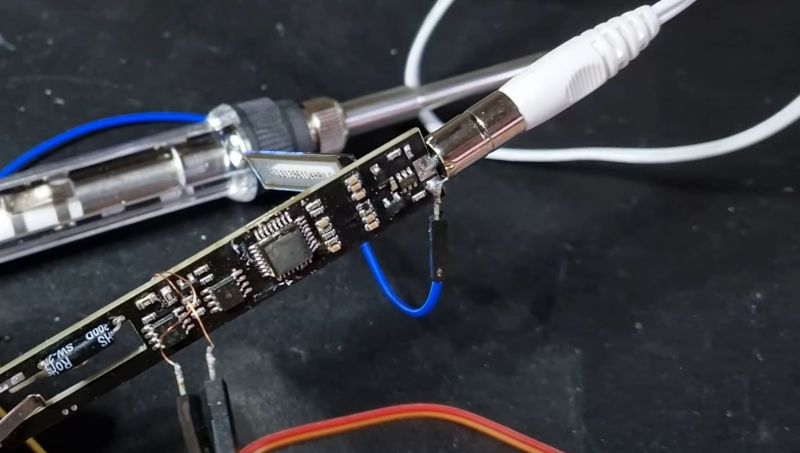With soldering irons being so incredibly useful, and coming on the heels of the success of a range of portable, all-in-one soldering irons from the likes of Waveshare and Pine64, it’s little wonder that you can get such devices for as little as 10 – 15 Euro from websites like AliExpress. Making for both a great impulse buy and reverse-engineering target, [Aaron Christophel] got his mittens on one and set to work on figuring out its secrets.
The results are covered in a brief video, as well as a Twitter thread, where this T12 soldering iron’s guts are splayed around and reprogrammed in all their glory. Despite the MCU on the PCB having had its markings removed, some prodding and poking around revealed it to be an STC8H3K62S2, an 8051-based MCU running at a blistering 11 MHz. As a supported PlaformIO target, reprogramming the MCU wasn’t too complicated after wiring up a USB-TTL serial adapter.
Completing this initial foray into these cheap T12 soldering irons is the GitHub repository, which contains the pin-outs, wiring diagrams and further information. Although [Aaron] indicates that he’ll likely not pursuing further development, the mixed responses by people to the overall quality of the firmware on the as-purchased T12 may inspire others to give it a shake.















Reverse engineering of closed devices is a good thing, but when purchasing I do my best to support Open Source devices, so although I have no use for a ucontroller in a solder iron, as soon as it became available I bought a Pinecil from pine64 as a way to support indirectly the PinePhone project, and was very positively impressed by its quality, and not just for the price: it’s a really good solder iron that I keep side by side with my Wellers.
I wonder if I could replace the MCU with an rpi 2040.
Of course.
“Just” not without some adapter.
Although the question would be why?
I beleive it would be simpler (and useful) to just build your own based on rp2040.
And it plays Bad Apple ;-)
https://twitter.com/atc1441/status/1632879248359792640
I get the idea of doing this, but if you don’t have a good soldering iron, just get a pinecil. At least you support an opensource platform with an insanely good product, replaceable parts, etc. And get the USB cables from them, as they are super flexible silicone cables. Makes soldering so much easier. I got my tips from aliexpress (ts100 tips).
Seconded, it’s the same price. You can also get tips thru the Pine64 store, though they’re a little pricey. Love that soldering iron.
To ytrewq and Bob, I get your point and I wholeheartedly support open source, but this is Hackaday and this is how we deal with closed source devices. It’s kinda the point of the site.
Waveshare don’t make soldering irons btw..
Ok apparently it’s been too long since I picked up a soldering iron, but… why do they have a microcontroller in the first place now? I’m pretty sure my last one was a dumb heating element plugged straight into the mains…
Temperature control (usually PID based) so you can have 30-60W of power for a quick turn on, but won’t overheat if left standing or used in tiny components, and will apply extra power if you try to solder something large and temperature falls.
It’s a soldering station inside a simple iron. Plus, you get a tiny screen to set the temperature (soldering stations, at least older ones, had a simple graduated knob you had to trust, and later a 7 segment LED display).
You just described a typical temperature-controlled iron, the likes of the Weller WTCP, which has been available for.. 45 years? And no uC is required – the temperature is controlled by a magnetic switch which is itself triggered by a slug of metal which is engineered to have a specific Curie temp. This system is simple and gives you both temp stability and load sensitivity.
Same way how older thermostats used a bending metal strip to react to temperature and now you have a digital one..
Cool, now compare the price of that Weller against a $15 pinecil.
Basically the appeal of these uC soldering irons is their performance rivals irons that are a couple hundred dollars, often for $50 or less, and thats not even considering their portability. Therefore they are very attractive to hobbyists.
As much as I love minimalist/low-tech devices we’re talking about different devices here. The essential features of such small MCU based irons to me are :
– portability : not every place you want to solder as a main plug nearby (drone repairing in the field anyone?). Having the opportunity to power a soldering iron through a pocket sized battery is essential
– temprerature boosting : the ability to temporary (at the press of a button) push the temperature to a desired value is a great addition when dealing with SMD based PCB with the occasional component soldered to a large ground plane
My friend just confessed to me he has one of those… Tuned for 60/40 solder it doesn’t work with leadfree….
I got one of these t12 jobs shown in the article. It works fine for crap work, ill stick with my pinecil or jbc stuff for details.
I modified it with a usb-c trigger set to 20 volts and it works fine with a 65 watt brick, albeit slow.
My only real issue is the menus. They are horrible. The abbreviations make no sense in English but the main screen with temperature control does its job.
If someone could rebuild the firmware with a usable menu structure it would be a fairly decent unit……for stuff u don’t need a properly grounded handle.